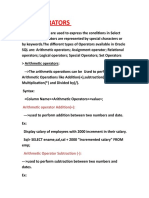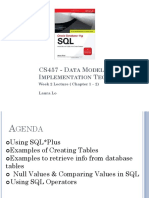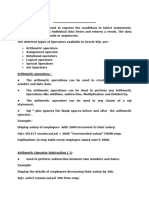0 ratings0% found this document useful (0 votes)
15 viewsSQL Operator
Uploaded by
MANAS TIWARICopyright
© © All Rights Reserved
We take content rights seriously. If you suspect this is your content, claim it here.
Available Formats
Download as PDF or read online on Scribd
0 ratings0% found this document useful (0 votes)
15 viewsSQL Operator
Uploaded by
MANAS TIWARICopyright
© © All Rights Reserved
We take content rights seriously. If you suspect this is your content, claim it here.
Available Formats
Download as PDF or read online on Scribd
You are on page 1/ 10
SQL Operators
Arithmetic operators
Addition operator (+): Adds two or more numeric values.
Eg.
SELECTS +4;
The result will be 9.
O Subtraction Operator (-): The - symbol subtracts one number from another
Eg.
SELECT 10-1
The result will be -1
© Multiplication (*): The * symbol multiplies two numbers together.
Eg.
SELECT 10* 10;
The result will be 100;
C Division (/): Divides one numeric value by another.
Eg.
SELECT 10/2;
The result will be 6.
GO Remainder/Modulus (%): The % symbol (sometimes referred to as Modulus)
returns the remainder of one number divided by another.
Eg
SELECT 10% 4;
The result will be 2.
C2 Bitwise AND (&): Performs a bit-by-bit comparison of two expressions and retums a
result that has 1s in the positions where both input expressions have 1s and 0s in all
other positions.
Eg.
SELECT 5 & 3;
The result would be 1.
C Bitwise OR (): Performs a bit-by-bit comparison of two expressions and retums a
result that has 18 in the positions where either of the input expressions has 1 and Os
in all other positions.
Eg.
SELECT 5 3;
The result would be 7.
C Bitwise XOR (4): Performs a bit-by-bit comparison of two expressions and
returns a result that has 1s in the positions where either of the input expressions has
4s but not both, and 0s in all other positions.
Eg.
SELECT 543;
The result would be 6.
C Bitwise NOT (~): inverts all the bits of an expression, effectively changing all Os
to 18 and all 1s to 0s.
Eg.
SELECT ~3;
The result would be -4.
C Left shift (<<): shits all the bts of an expression to the lot by a specified
number of positions.
Eg.
SELECT 5 << 1;
The result would be 10.
© Right shift (>>): shifts all the bits of an expression to the right by a specified
number of positions.
Eg.
SELECT 5 >> 1;
The result would be 2.
1D Name SALARY
1 John 45000
2 Jane 50000
3 Bob. 55000
4 Alice 60000
Table: Employees
© Equal to (=): Retums true if two expressions are equal
Eg,
‘SELECT Name FROM employees WHERE salary = 50000;
This query would return Name from the employees table where the value in the salary column
#s equal to 50000.
~ Output
Jane
O Not equal to (<> or !=)
Retums true if two expressions are not equal.
Eg
‘SELECT Name FROM employees WHERE salary != 50000;
This query would return Name from the employees table where the value in the salary column
és not equal to 50000.
~ Output
John
Bob
Alice
C Greater than (>): Retums true ifthe first expression is greater than the second
expression.
Eg
‘SELECT Name FROM employees WHERE salary > 50000;
This quory would return Name from the employees table where the value in the salary column
és greater than 50000,
~ Output
Bob
Alice
CO Less than (<): Retums true ifthe fist expression is less than the second
expression.
Eg.
SELECT Name FROM employees WHERE salary < 50000;
This query would return Name from the employees table where the value in the salary column
fs less than 0000,
~ Output
John
O Greater than or equal to (>=): Retums true ifthe first expression is greater
than or equal to the second expression.
Eg.
‘SELECT Name FROM employees WHERE salary >= 55000;
This query would return Name from the employees table where the value in the salary column
is greater than or equal to 50000.
~ Output
Bob
Alice
C Less than or equal to (<=): Returns true ifthe first expression is less than or
equal to the second expression.
Eg
‘SELECT Namo FROM employees WHERE salary <= 50000;
This quory would return Name from the employees table where the value in the salary column
is less than or equal to 50000.
~ Output
John
Jane
first_name last_name age location
John’ Doe 35 New york.
Jane Smith 40 London
Bob Johnson, 45 Paris
Alice Brown 50 London
Charlie Wilson 30 Tokyo
Table: users
O ALL
The ALL operator returns TRUE if all of the subquery values meet the specified
condition. In the below example, we are filtering all users who have an age that is
greater than the highest age of users in London.
‘SELECT first_name, last_name, age, location
FROM users
WHERE age > ALL (SELECT age FROM users WHERE location = ‘London’);
Output:
first_name | last_name age location
Bob Johnson 45 Paris
Alice Brown 50 London
O ANY/SOME
The ANY operator returns TRUE if any of the subquery values meet the specified
condition. In the below example, we are filtering all praducts which have any record
in the orders table. The SOME operator achieves the same result.
SELECT first_name
FROM users
WHERE age > ANY (SELECT age FROM users);
Output:
first_name
John’
Jane
Bob:
Alice
Charlie
O AND
‘The AND operator returns TRUE if all of the conditions separated by AND are true. In
the below example, we are filtering users that have an age of 20 and a location of,
London,
SELECT*
first_name | last_name age location
Alice Brown 50 London
O BETWEEN
‘The BETWEEN operator filters your query to only return results that fit a specified
range.
SELECT*
FROM users
WHERE age BETWEEN 40 AND 50;
Output:
first_name last_name age location
Jane Smith 40 London
Bob Johnson 45 Paris
Alice Brown 50 London
O exists
‘The EXISTS operator is used to fitter data by looking for the presence of any record
ina subquery.
SELECT*
FROM usors
WHERE EXISTS (SELECT 1 FROM users WHERE location = ‘London’);
Output:
first_name last_name age location
Jane ‘Smith 40 London
Alice Brown 50 London
OIN
‘The IN operator includes multiple values set into the WHERE clause.
SELECT*
FROM users
WHERE first_name IN (‘Bob’, ‘Fred’, ‘Harry’);
Output:
first_name | last_name age location
Bob Johnson 45 Paris
O NOT
‘The NOT operator retums results if the condition or conditions are not true.
SELECT*
FROM users
WHERE first_name NOT IN (‘Bob’, ‘Fred’, ‘Harry’);
Output:
first_name last_name age location
John Doe 35 New york
Jane ‘Smith 40 London
Alice Brown 50 London
Charlie Wilson 30 Tokyo
OOR
‘The OR operator retums TRUE if any of the conditions separated by OR are true. In
the below example, we are filtering users that have an age of 30 or a location of
London.
SELECT
FROM users
WHERE age = 30 OR location = ‘London’;
Output:
first_name last_name age location
Jane Smith 40 London
Alice Brown 50 London
Chattie ‘Wilson 30 Tokyo
OS NULL
The IS NULL operator is used to filtering results with a value of NULL.
SELECT *
FROM users
WHERE age IS NULL;
Output
Empty result, as no record has age column NULL;
O LIKE
The LIKE operator searches for a specified pattern in a column. (For more
information on how!why the % is used here, see the section on the wildcard
character operator).
SELECT
FROM users
WHERE first_name LIKE ‘%4Bob%';
Output:
first_name | last_name age
Bob Johnson 45
NOT LIKE operator: The NOT LIKE operator is used to searching for a
specified pattern in a string and return the opposite of the LIKE operator.
SELECT*
FROM users
WHERE first_name NOT LIKE 'J%';
Output:
first_name last_name age location
John: Doe 35 New york
Jane Smith 40 London
C Concatenation operator (||): The concatenation operator is used to combine
{wo or more strings into a single string.
Example:
SELECT first_name ||" ‘|| last_name AS full_name
FROM users;
Output:
You might also like
- Data Analysis With SQL: Mysql Cheat SheetNo ratings yetData Analysis With SQL: Mysql Cheat Sheet4 pages
- Database Administration and Management: SQL LabNo ratings yetDatabase Administration and Management: SQL Lab38 pages
- SQL Operators: What Is An Operator in SQL?No ratings yetSQL Operators: What Is An Operator in SQL?8 pages
- Lecture 13 - Restricting Rows and SortingNo ratings yetLecture 13 - Restricting Rows and Sorting27 pages
- Postgresql (The Version of SQL We'Re Using)100% (1)Postgresql (The Version of SQL We'Re Using)13 pages
- Experiment-2: Quires Using Operators in SQLNo ratings yetExperiment-2: Quires Using Operators in SQL6 pages
- Select FROM Emp : 4.1.retrieving Information From A TableNo ratings yetSelect FROM Emp : 4.1.retrieving Information From A Table6 pages
- Chaper No.2 Ravindra Babasaheb Nagare DMANo ratings yetChaper No.2 Ravindra Babasaheb Nagare DMA34 pages
























































